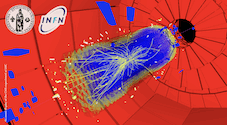Dr
Monica Scaringella
(Univeristà di Firenze)
07/07/2011, 09:00
Talk
To harvest the maximum physics potential of the LHC, it is foreseen to significantly increase the luminosity by upgrading towards the HL-LHC (High Luminosity LHC). This will mean unprecedented radiation levels, exceeding the LHC fluences tenfold. Due to radiation damage to the silicon sensors presently used, the physics experiments will require new tracking detectors. Within the CERN RD50...
Giuliano Parrini
(INFN-FI and Università degli Studi Firenze)
07/07/2011, 09:20
Semiconductor Detectors
Talk
Silicon and its technology are the reference points in the sensor/electronics fields. Anyway niche sectors exist where Diamond plays either a competitive or an exclusive role with respect to Silicon. Broadly speaking, sensors placed near the accelerator beams, biological Multi Electrode Arrays (MEA) and neuro-prosthesis applications are such sectors.
In these last years the rise of laser...
Dr
Riccardo Mori
(INFN Firenze and Dip Energetica Univ. Firenze)
07/07/2011, 09:40
Semiconductor Detectors
Talk
Investigation on the influence of defect states on the electrical properties of disordered semiconductor materials is strategic in the perspective of increasing the efficiency of devices in several application fields as clinical radiotherapy (a-Si, polycrystalline diamond..), solar cells ( a-Si, nanostructured TiO2, .. ) , particle detectors (Si, SiC ...). It is well known that materials used...
Mr
Joachim Erfle
(University of Hamburg)
07/07/2011, 10:00
Talk
CMS started a campaign to identify the future silicon sensor technology baseline for a new Tracker for the high-luminosity phase of LHC. We ordered a large variety of 6” wafers in different thicknesses and technologies at HPK. Thicknesses ranging from 50µm to 300µm are explored on floatzone, magnetic Czochralski and epitaxial material both in n-in-p and p-in-n versions. P-stop and p-spray are...
Jose Bernabeu
(IFIC - Insituto de Fisica Corpuscular (CSIC-UV))
07/07/2011, 10:20
Talk
While the Large Hadron Collider (LHC) at CERN is continuing to deliver an ever-increasing luminosity to the experiments, plans for an upgraded machine called Super-LHC (sLHC) are progressing. The upgrade is foreseen to increase the LHC design luminosity by a factor ten. The ATLAS experiment will need to build a new tracker for sLHC operation, which needs to be suited to the harsh sLHC...
Dr
Giovanni Marchiori
(LPNHE Paris)
07/07/2011, 11:10
Semiconductor Detectors
Talk
To extend the physics reach of the LHC, upgrades to the accelerator are planned which will increase the peak luminosity by a factor 5 to 10. To cope with the increased occupancy and radiation damage, the ATLAS experiment plans to introduce an all-silicon inner tracker with the HL-LHC upgrade. For radiation damage reasons, only electron-collecting sensors designs are considered (n-in-p and...
Dr
Claudia Gemme
(INFN Genova)
07/07/2011, 11:30
Semiconductor Detectors
Talk
The upgrades for the ATLAS Pixel Detector will be staged in preparation for high luminosity LHC. The first upgrade for the Pixel Detector will be the construction of a new pixel layer which will be installed during the first shutdown of the LHC machine, foreseen in 2013-14. The new detector, called the Insertable B-layer (IBL), will be installed between the existing Pixel Detector and a new,...
Mr
Julien Mekki
(CERN)
07/07/2011, 11:50
Talk
The ‘Large Hadron Collider (LHC) is a complex radiation environment consisting of several particles types at different energies. The RadMon detector is conceived to measure the radiation effects on the electronics in the LHC tunnel and its adjacent shielded areas in order to monitor the radiation levels, anticipate possible device degradation and identify instantaneous failures of the...
Mr
Simone Bianco
(HISKP, Bonn Universität)
07/07/2011, 12:10
Talk
A tracking station composed of silicon strip sensors has been designed, built and tested.
It is a beam telescope equipped with four boxes containing single-sided and double-sided silicon strip sensors.
The boxes can be moved along the longitudinal direction and one module can be rotated changing the incident angle of the beam. These features allow studying in detail the effects of changes...
Dr
gerardus nooren
(utrecht university / nikhef)
07/07/2011, 12:30
Talk
Calorimetry at small forward angles at the LHC poses several challenges. The particle density is very high, especially in Pb-Pb. Further, in the electromagnetic case the discrimination of photons and pi0 requires extremely fine granularity due to the small angle between the decay photons of the pion.
We present a design of a silicon - tungsten calorimeter with Monolithic Active Pixels as...

